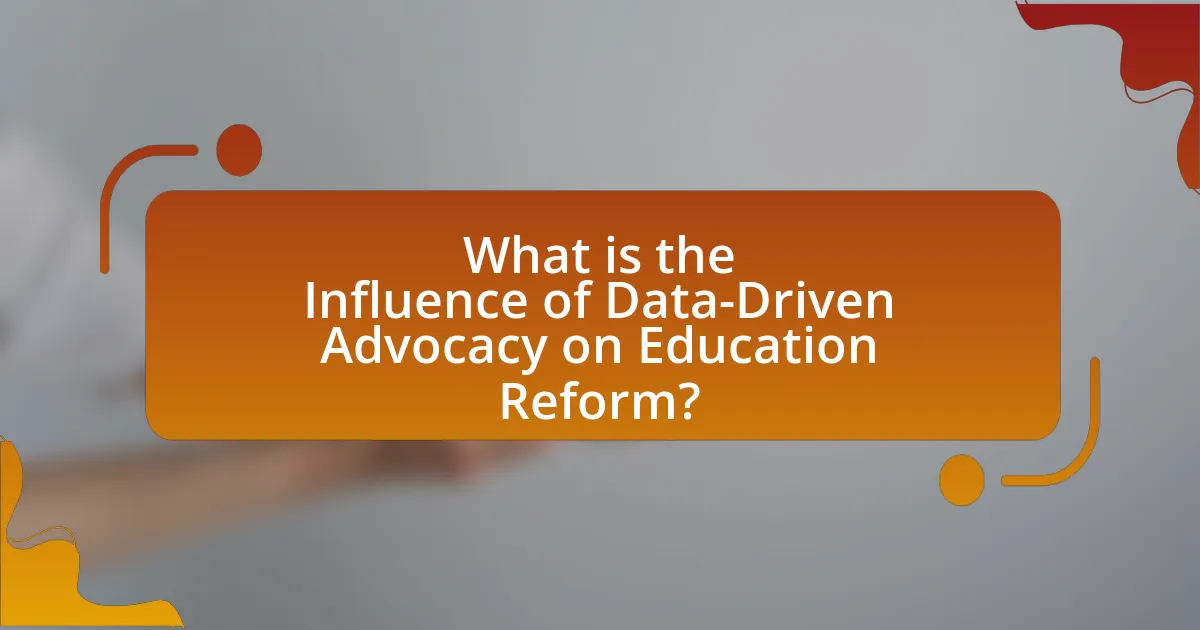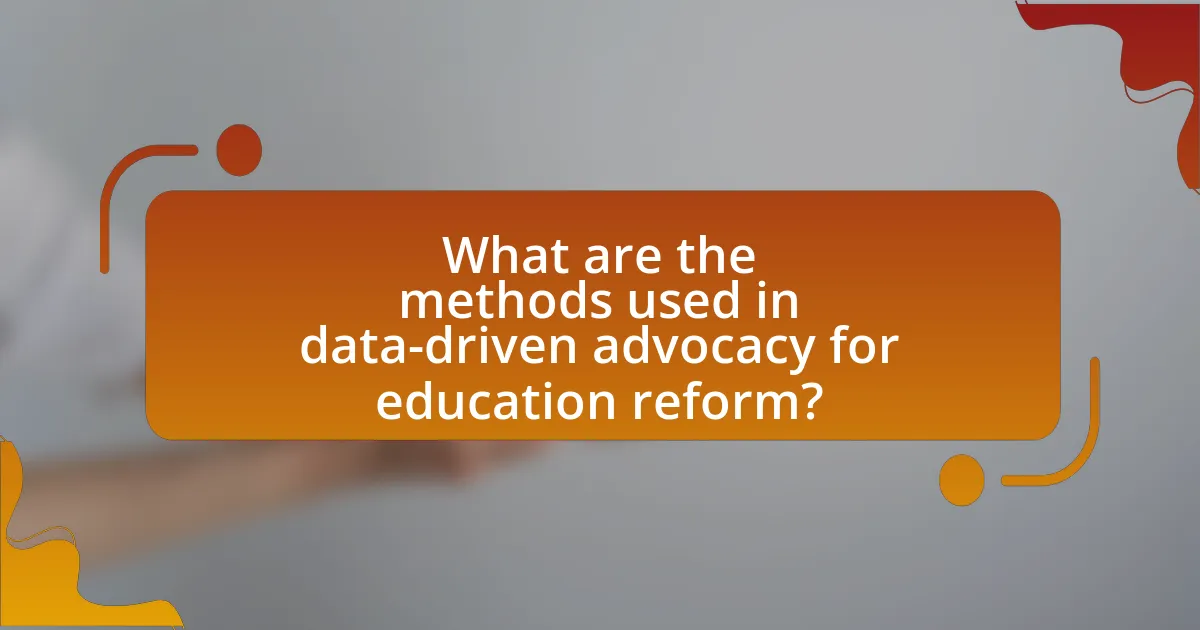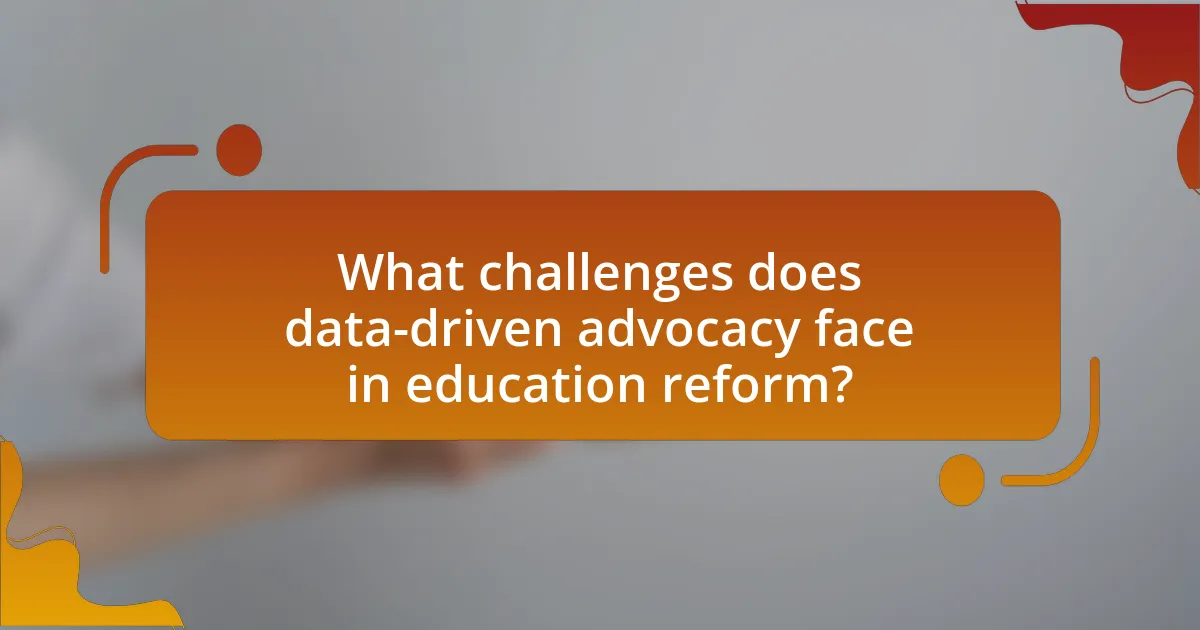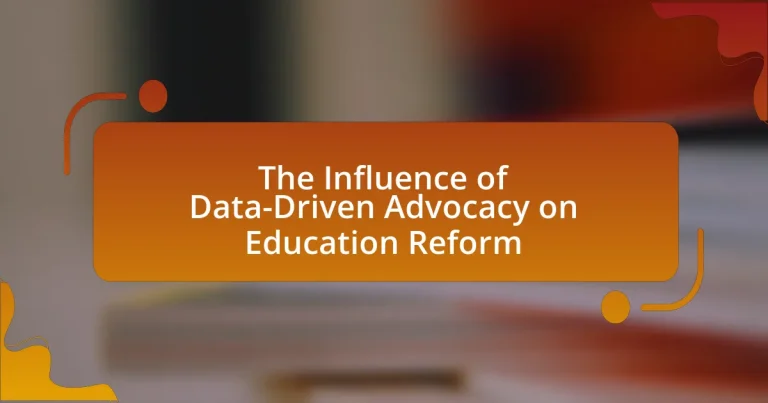Data-driven advocacy plays a crucial role in shaping education reform by utilizing empirical evidence to inform policy decisions and educational practices. This approach involves data collection, analysis, and stakeholder engagement to identify gaps in educational outcomes and advocate for targeted interventions. Key components include the use of quantitative and qualitative data to highlight disparities, enhance accountability, and improve decision-making among stakeholders. The article explores the methods, benefits, challenges, and ethical considerations of data-driven advocacy, emphasizing its importance in driving effective educational reforms and improving student achievement.

What is the Influence of Data-Driven Advocacy on Education Reform?
Data-driven advocacy significantly influences education reform by providing empirical evidence that shapes policy decisions and educational practices. This approach utilizes data analytics to identify gaps in educational outcomes, enabling stakeholders to advocate for targeted interventions. For instance, studies have shown that data-driven initiatives can lead to improved student performance; a report from the Bill & Melinda Gates Foundation found that schools using data effectively saw a 10% increase in student achievement. By leveraging data, advocates can present compelling arguments to policymakers, ensuring that reforms are grounded in measurable outcomes and addressing the specific needs of students and communities.
How does data-driven advocacy shape educational policies?
Data-driven advocacy shapes educational policies by providing empirical evidence that informs decision-making processes. This approach utilizes quantitative data, such as student performance metrics and demographic statistics, to highlight areas needing reform and to support specific policy proposals. For instance, research from the National Center for Education Statistics shows that data analysis can identify achievement gaps among different student populations, prompting targeted interventions. Additionally, organizations like the Data Quality Campaign advocate for the use of data to drive policy changes, emphasizing the importance of transparency and accountability in education systems. By leveraging data, advocates can effectively influence policymakers to adopt evidence-based strategies that improve educational outcomes.
What are the key components of data-driven advocacy in education?
The key components of data-driven advocacy in education include data collection, analysis, communication, and stakeholder engagement. Data collection involves gathering quantitative and qualitative information on educational outcomes, demographics, and resource allocation. Analysis transforms this data into actionable insights, identifying trends and gaps in the education system. Effective communication disseminates these insights to stakeholders, including policymakers, educators, and the community, using clear and compelling narratives. Finally, stakeholder engagement ensures that diverse voices are included in the advocacy process, fostering collaboration and support for educational reforms. These components work together to create a robust framework for influencing education policy and practice.
How do these components interact with existing educational frameworks?
Data-driven advocacy components interact with existing educational frameworks by providing empirical evidence that informs policy decisions and instructional practices. These components, such as data analysis, stakeholder engagement, and evidence-based strategies, enhance the effectiveness of educational reforms by aligning them with measurable outcomes. For instance, studies have shown that data-informed decision-making leads to improved student performance, as seen in the 2018 report by the Institute of Education Sciences, which highlighted that schools utilizing data effectively saw a 10% increase in student achievement. This integration of data-driven approaches into educational frameworks ensures that reforms are not only relevant but also responsive to the needs of students and educators.
Why is data-driven advocacy important for education reform?
Data-driven advocacy is crucial for education reform because it provides evidence-based insights that inform policy decisions and improve educational outcomes. By utilizing data, advocates can identify specific areas needing reform, measure the effectiveness of existing programs, and demonstrate the impact of proposed changes. For instance, studies show that data-driven approaches can lead to a 20% increase in student achievement when targeted interventions are implemented based on analyzed data. This reliance on concrete metrics ensures that reforms are not based on assumptions but on verifiable evidence, ultimately leading to more effective educational policies.
What benefits does data-driven advocacy provide to stakeholders?
Data-driven advocacy provides stakeholders with enhanced decision-making capabilities, allowing them to base their strategies on empirical evidence rather than assumptions. This approach leads to more effective policy formulation and implementation, as stakeholders can identify trends, measure outcomes, and allocate resources efficiently. For instance, a study by the Bill & Melinda Gates Foundation found that data-driven initiatives in education reform resulted in a 20% increase in student achievement in targeted districts, demonstrating the tangible benefits of using data to inform advocacy efforts.
How does it enhance accountability in educational systems?
Data-driven advocacy enhances accountability in educational systems by providing measurable outcomes and transparent performance metrics. This approach allows stakeholders, including educators, administrators, and policymakers, to assess the effectiveness of educational programs and initiatives based on empirical evidence. For instance, the use of standardized testing data enables schools to identify achievement gaps and allocate resources more effectively, thereby holding educators accountable for student performance. Research from the National Center for Education Statistics indicates that data-driven decision-making can lead to improved student outcomes, as schools that utilize data effectively show higher rates of academic achievement.

What are the methods used in data-driven advocacy for education reform?
Data-driven advocacy for education reform employs methods such as data collection, analysis, visualization, and storytelling to influence policy decisions. These methods enable advocates to present compelling evidence that highlights educational disparities and the effectiveness of proposed reforms. For instance, organizations like the Data Quality Campaign utilize data collection to track student outcomes and inform stakeholders about necessary changes in education policy. Additionally, data visualization tools help to simplify complex information, making it accessible to policymakers and the public, thereby enhancing the impact of advocacy efforts.
How is data collected and analyzed for advocacy purposes?
Data for advocacy purposes is collected through various methods such as surveys, interviews, focus groups, and existing data sources like government reports and academic studies. These methods allow advocates to gather quantitative and qualitative information relevant to their cause.
Once collected, data is analyzed using statistical tools and qualitative analysis techniques to identify trends, patterns, and insights that support advocacy efforts. For instance, the analysis may reveal disparities in educational outcomes among different demographic groups, which can be crucial for informing policy changes.
Research shows that data-driven advocacy can significantly influence education reform by providing evidence-based arguments that resonate with policymakers and stakeholders. For example, a study by the Center for American Progress highlights how data analysis led to the successful implementation of new educational policies in several states, demonstrating the effectiveness of data in driving change.
What types of data are most relevant to education reform?
Quantitative data, qualitative data, and demographic data are the most relevant types of data for education reform. Quantitative data includes standardized test scores, graduation rates, and attendance records, which provide measurable insights into student performance and educational outcomes. Qualitative data, such as surveys and interviews with students, teachers, and parents, offers context and deeper understanding of the educational environment and stakeholder experiences. Demographic data, including socioeconomic status, ethnicity, and geographic location, helps identify disparities and target interventions effectively. These data types collectively inform policy decisions, highlight areas needing improvement, and guide resource allocation in education reform efforts.
How do data analysis techniques influence advocacy strategies?
Data analysis techniques significantly influence advocacy strategies by providing evidence-based insights that shape policy recommendations and mobilize support. For instance, the use of statistical analysis allows advocates to identify trends in educational outcomes, such as disparities in student performance across demographics, which can be pivotal in targeting interventions. Research by the Data Quality Campaign highlights that data-driven advocacy has led to increased funding for under-resourced schools by demonstrating the correlation between funding levels and student achievement. This evidence not only strengthens the argument for policy changes but also engages stakeholders by presenting clear, quantifiable benefits of proposed reforms.
What role do technology and tools play in data-driven advocacy?
Technology and tools are essential in data-driven advocacy as they enable the collection, analysis, and dissemination of data to inform decision-making and influence policy changes. For instance, data visualization tools help advocates present complex information in an accessible format, making it easier for stakeholders to understand the implications of educational data. Additionally, platforms for data collection, such as surveys and analytics software, allow organizations to gather real-time feedback and measure the impact of their initiatives. Research shows that organizations utilizing technology in advocacy efforts can increase engagement and mobilize support more effectively, as evidenced by the rise of social media campaigns that leverage data to drive public awareness and action in education reform.
Which technologies are most effective for data collection in education?
The most effective technologies for data collection in education include Learning Management Systems (LMS), student information systems (SIS), and online survey tools. LMS platforms like Canvas and Moodle facilitate the collection of student performance data, engagement metrics, and course completion rates, enabling educators to analyze learning outcomes effectively. SIS, such as PowerSchool, manage student data, attendance records, and academic performance, providing comprehensive insights into student progress. Online survey tools like Google Forms and SurveyMonkey allow educators to gather feedback from students and parents, enhancing the understanding of educational needs and experiences. These technologies are validated by their widespread adoption in educational institutions, demonstrating their effectiveness in supporting data-driven decision-making and educational reform.
How do digital platforms facilitate advocacy efforts?
Digital platforms facilitate advocacy efforts by providing tools for communication, mobilization, and data sharing. These platforms enable organizations and individuals to reach a broader audience quickly, allowing for the dissemination of information and calls to action. For instance, social media platforms like Twitter and Facebook have been instrumental in organizing campaigns, as they allow users to share messages widely and engage with supporters in real-time. According to a study by the Pew Research Center, 69% of adults in the U.S. use social media, which highlights the potential reach of advocacy messages. Furthermore, digital platforms offer analytics tools that help advocates measure engagement and adjust strategies based on data-driven insights, enhancing the effectiveness of their efforts in influencing education reform.

What challenges does data-driven advocacy face in education reform?
Data-driven advocacy in education reform faces challenges such as data accessibility, data interpretation, and stakeholder resistance. Limited access to high-quality data can hinder the ability of advocates to make informed decisions and recommendations. Additionally, the complexity of data interpretation can lead to miscommunication or misrepresentation of findings, which may undermine the credibility of advocacy efforts. Furthermore, resistance from stakeholders, including educators and policymakers, can arise due to differing priorities or skepticism about the validity of data-driven approaches. These challenges can impede the effectiveness of advocacy initiatives aimed at reforming educational practices and policies.
What are the common obstacles to implementing data-driven advocacy?
Common obstacles to implementing data-driven advocacy include data accessibility, lack of technical expertise, and resistance to change. Data accessibility issues arise when organizations face difficulties in obtaining relevant and high-quality data, which is essential for informed decision-making. The lack of technical expertise can hinder the effective analysis and interpretation of data, limiting the ability to leverage insights for advocacy efforts. Additionally, resistance to change from stakeholders, including educators and policymakers, can obstruct the adoption of data-driven approaches, as they may prefer traditional methods or be skeptical of data’s role in decision-making. These obstacles collectively impede the successful integration of data-driven strategies in advocacy for education reform.
How do political and institutional barriers impact advocacy efforts?
Political and institutional barriers significantly hinder advocacy efforts by limiting access to decision-makers and resources. These barriers can manifest as restrictive legislation, bureaucratic red tape, or lack of political will, which obstruct the implementation of advocacy initiatives. For instance, in the context of education reform, advocacy groups may struggle to influence policy changes due to entrenched interests or opposition from powerful stakeholders, such as unions or political parties. Research indicates that in states with stringent lobbying laws, advocacy organizations face challenges in mobilizing support and resources, ultimately stifling their effectiveness in driving educational reforms.
What ethical considerations arise in data-driven advocacy?
Data-driven advocacy raises several ethical considerations, primarily concerning data privacy, informed consent, and the potential for bias. Data privacy issues arise when personal information is collected and used without adequate safeguards, potentially exposing individuals to harm. Informed consent is critical, as stakeholders must understand how their data will be used and the implications of its use. Additionally, bias can occur in data collection and analysis, leading to misrepresentation of marginalized groups, which can skew advocacy efforts and policy recommendations. For instance, a study by the Data & Society Research Institute highlights that biased algorithms can perpetuate existing inequalities, emphasizing the need for ethical frameworks in data-driven advocacy to ensure fairness and accountability.
How can data-driven advocacy be improved for better outcomes?
Data-driven advocacy can be improved for better outcomes by enhancing data collection methods, ensuring data accuracy, and fostering collaboration among stakeholders. Improved data collection methods, such as utilizing real-time analytics and community feedback, allow advocates to gather relevant information that reflects current educational needs. Ensuring data accuracy through rigorous validation processes helps build trust in the findings, which is crucial for effective advocacy. Collaboration among stakeholders, including educators, policymakers, and community members, facilitates a comprehensive understanding of the issues at hand and promotes the sharing of best practices. For instance, research by the Data Quality Campaign highlights that states with strong data governance frameworks see a 20% increase in effective policy implementation, demonstrating the importance of these improvements in achieving better advocacy outcomes.
What best practices should advocates follow to enhance effectiveness?
Advocates should utilize data-driven strategies to enhance their effectiveness. By leveraging empirical evidence, advocates can make informed arguments that resonate with policymakers and stakeholders. For instance, research from the Center for American Progress indicates that data-informed advocacy leads to more successful policy outcomes, as it provides concrete evidence of the issues at hand and potential solutions. Additionally, advocates should engage in coalition-building to amplify their voices and share resources, as collaborative efforts have been shown to increase the impact of advocacy initiatives.
How can collaboration among stakeholders strengthen advocacy efforts?
Collaboration among stakeholders can strengthen advocacy efforts by pooling resources, expertise, and diverse perspectives to create a unified and compelling message. When various stakeholders, such as educators, policymakers, and community organizations, work together, they can leverage their collective influence to drive policy changes more effectively. For instance, a study by the National Education Association found that coalitions of stakeholders advocating for education reform were more successful in passing legislation than isolated efforts, demonstrating that collaboration enhances credibility and amplifies voices in the advocacy process.
What practical steps can educators take to leverage data-driven advocacy?
Educators can leverage data-driven advocacy by systematically collecting and analyzing relevant data to inform their strategies. This involves identifying key performance indicators, such as student achievement metrics and demographic data, to highlight areas needing improvement. By presenting this data to stakeholders, educators can effectively advocate for necessary resources and policy changes. For instance, a study by the Bill & Melinda Gates Foundation found that data-informed decision-making in schools led to improved student outcomes, demonstrating the impact of using concrete data in advocacy efforts.


